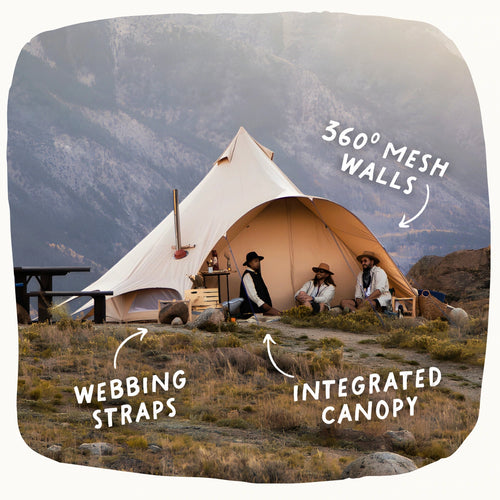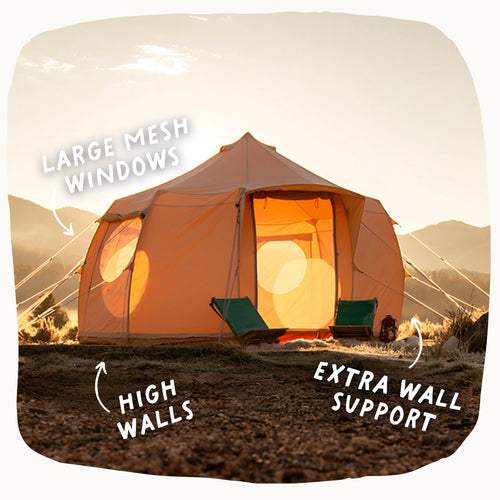BC GUIDE: Master the Art of Seasonal Tent Storage.
INSPECT FOR WEAR & TEAR

OPTION 1: D.I.Y.
OPTION 2: OUTSOURCE.
CLEAN & REPROOF

CLEANING YOUR TENT.
-
Gather Your Supplies:
- A soft brush or sponge
- A mild, non-detergent soap (Nikwax Tech Wash or Granger's Performance Wash are good options)
- A bathtub or large container
- A hose (for rinsing, if available)
- Mildew remover (if needed)
- A cloth for scrubbing
-
Remove Stakes and Poles: Take down the tent and remove all stakes, poles, and guy lines.
-
Set Up the Tent: If possible, set up the tent in a clean, dry, and well-ventilated area. This makes it easier to clean.
-
Brush Off Debris: Use a soft brush or sponge to remove loose dirt and debris from the tent's surface. Gently scrub any heavily soiled areas.
-
Prepare a Cleaning Solution: Fill a container or bathtub with cool to lukewarm water. Add the mild soap and mix it in. If you have mildew or mold spots, use a mildew remover according to the manufacturer's instructions.
-
Spot Clean Stains: Dip a cloth in the soapy water and spot-clean any stubborn stains or mildew spots. Gently scrub the affected areas.
-
Wash the Entire Tent: Immerse the entire tent in the soapy water, making sure the zippers are open. Gently agitate the water to clean the tent's fabric. Avoid excessive rubbing or scrubbing, as it can damage the waterproof coating.
-
Rinse Thoroughly: After cleaning, rinse the tent thoroughly with clean water to remove all soap residues. If you have access to a hose, this can be very effective.
-
Hang to Dry: Hang the tent or spread it out in a well-ventilated area to air dry. Avoid direct sunlight and do not pack it away until it is completely dry. Ensure it is dry to the touch both inside and out.
REPROOFING YOUR TENT.
-
Gather Your Supplies:
- A suitable tent waterproofing product (Nikwax Tent & Gear SolarProof or Granger's Tent + Gear Repel are good options)
- A clean sponge or cloth
- A well-ventilated area
-
Ensure the Tent is Clean: Your tent must be completely clean and dry before reproofing.
-
Apply the Reproofing Product: In a well-ventilated area, apply the tent waterproofing product according to the manufacturer's instructions. Typically, you'll use a sponge or cloth to apply it evenly to the tent fabric.
-
Pay Attention to Seams and Zippers: Be sure to apply the reproofing product to seams, zippers, and any areas that are prone to leakage.
-
Allow to Dry: Let the tent dry completely, typically for several hours, or as instructed on the product label.
-
Test for Waterproofing: To test the reproofing, spray some water on the tent's surface. If the water beads up and rolls off, your tent is successfully reproofed.
PACKING YOUR TENT

Folding a tent and returning it to its storage bag may seem like a straightforward task, but for those who haven't had much experience with camping gear, it can often prove to be a somewhat perplexing process. Yet, mastering this skill is essential for campers and outdoor enthusiasts alike, as it ensures the efficient use of space, helps maintain the tent's condition, and facilitates hassle-free setup during your next adventure. Let's delve into a detailed step-by-step guide on how to expertly fold a tent and stow it away neatly.
PRE-PACKING PRECAUTIONS.
1. Allow some time to air out the tent. Permitting the weather is dry, you can do this by unzipping windows and doors. This will remove moisture, prevent mould & mildew, eliminate odour and maintain fabric health.
2. Ensure your tent, including the groundsheet, is BONE DRY.
3. Clean and dry your poles and pegs before packing them separately in their bags.
STORING YOUR TENT

-
Cool Temperature: Opt for a storage area with a stable and moderate temperature. Extreme heat or cold can affect the tent fabric and coatings, so avoid attics or uninsulated spaces.
-
Elevated Storage: Whenever possible, store the tent off the ground. This prevents damage from pests, rodents, or potential flooding. You can use shelves, hooks, or a designated storage rack.
-
Proper Ventilation: Ensure there is adequate ventilation in the storage space to prevent trapped moisture and musty odours. This can be achieved with windows, vents, or a dehumidifier if needed.
-
Avoid Direct Sunlight: Prolonged exposure to direct sunlight can damage tent fabrics and coatings. Keep your tent away from UV rays, which can weaken the material over time.
-
Use a Storage Bag: If your tent came with a storage bag, use it. If not, invest in a breathable storage bag or stuff sack that is large enough to comfortably fit your tent without excessive compression.
-
Store Poles Separately: Keep tent poles separate from the tent body and fly. This prevents pressure on the fabric and keeps the poles from causing damage.
-
Label and Organise: If you have multiple camping gear items, label your storage bags or containers for easy identification. This ensures you can quickly locate your tent when needed.
-
Regular Check-Ups: Periodically inspect your stored tent throughout the off-season to ensure it's in good condition. Address any issues promptly to prevent them from getting worse.
-
Protect Against Pests: Use pest deterrents like mothballs or cedar chips to keep insects and rodents away from your stored tent.
In the world of camping and outdoor adventures, the right care for your tent during the off-season can make all the difference when the next season rolls around. Our blog, "Mastering the Art of Seasonal Tent Storage: Your Ultimate Guide," takes you through the essential steps to ensure your trusty tent is stored away in top condition. From thorough cleaning to inspecting for wear and tear, proper folding, and choosing the ideal storage location, this guide equips you with the knowledge to safeguard your tent from the elements, pests, and wear and tear. By mastering the art of seasonal tent storage, you'll guarantee your tent is always ready to provide you with a comfortable and reliable shelter for your next camping adventure.














Leave a comment